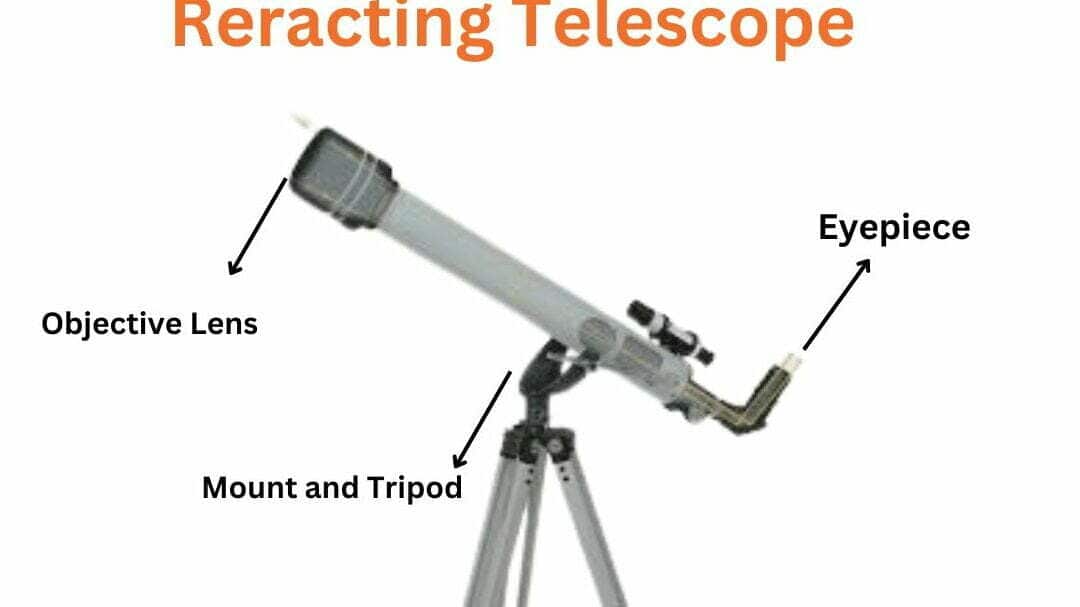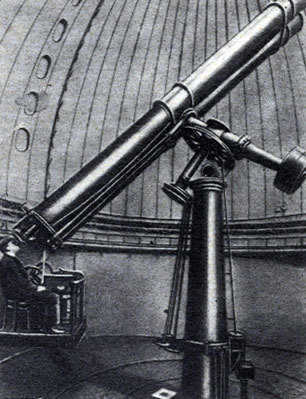
The amount of light energy gathered by a telescope is determined by the size of its objective lens. The larger the lens’s surface area, the better the telescope can observe faint luminous objects.
When light passes through the objective lens of a refractor telescope, it is refracted and forms an image of the object in the focal plane (Fig. 3, a). In a reflector telescope, the light is reflected by a concave mirror and also collected in the focal plane (Fig. 3, b). The image of the celestial object created by the objective lens can be viewed through an eyepiece lens or captured in a photograph.
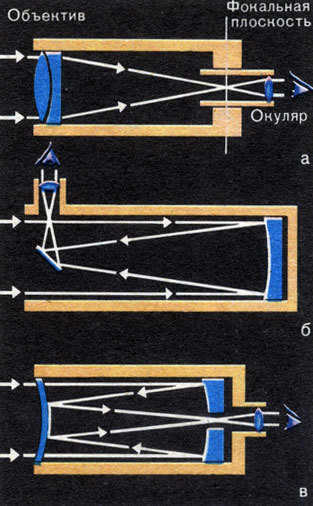
When constructing a telescope lens, the goal is to minimize the distortion that is inherent in the image of objects. The use of a simple lens can result in significant distortion and coloration around the edges of the image. To address these drawbacks, the objective lens is comprised of multiple lenses with differing surface curvatures and made from various types of glass. In addition, the concave glass mirror surface, which is either silvered or aluminized, is shaped in a parabolic form rather than a spherical one in order to reduce distortion.
The meniscus telescope system, developed by Soviet optician D. D. Maksutov, combines the advantages of both refractor and reflector telescopes. One of the models used in schools is based on this system. The meniscus, a thin convex-curved glass, corrects the distortion caused by a large spherical mirror. The rays reflected from the mirror are then reflected from the silvered area on the inner surface of the meniscus and directed into the eyepiece, which is a short-focus lens (Fig. 4,c). There are also other types of telescopic systems.
This telescope increases the apparent size of the Sun, Moon, planets, and their details, as well as the apparent distances between them. However, stars can only be seen as luminous points in any telescope due to their great distance.
A telescope typically produces an inverted image, but this is inconsequential when observing objects in space. Adding extra lenses to the eyepiece can transform the telescope into one that produces straight images, although some light may be lost.
When using a telescope for observations, magnifications rarely exceed 500x. This is due to the fact that air currents cause distortions in the image, which become more pronounced at higher magnifications.
The largest refractor telescope has a lens with a diameter of approximately 1 meter. The reflector telescope with the world’s largest concave mirror has a diameter of 6 meters. This particular telescope was manufactured in the USSR and is installed in the Caucasus Mountains. It enables the observation of stars that are tens of millions of times fainter than those visible to the naked eye.
I am curious if it is possible to create a telescope mirror that is not made of glass.
When we were producing glass for a 6-meter reflector, we had to ensure that the cooling process was done evenly and slowly, taking almost a year, to prevent any potential bursting.
Essentially, the mirror itself is made up of a layer of silver, while the glass serves as the underlying base for the mold.
Have there been any attempts to create a reflector using aluminum, similar to how it is done in the production of HDD disks?
One possibility would be to weld aluminum pieces together on a slipway, polish the surface, and then apply a silver coating in a vacuum chamber.

On August 18, 2023, at 00:01 AM, Saturn will be visible in the sky.
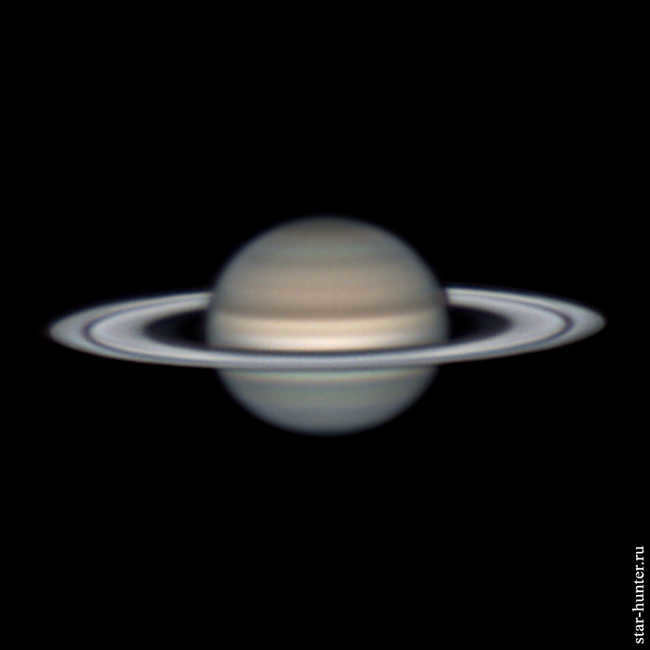
Equipment:
-Sky-Watcher Dob 14 (350/1600) Retractable SynScan GOTO telescope
-Lensblock Barlow NPZ PAG 3-5x
-atmospheric dispersion corrector ZWO ADC
-ZWO IR-cut light filter
-astronomical camera ZWO ASI 183MC.
Location: Caucasus Mountain Observatory, Moscow State University, Karachay-Cherkess Republic.
Here is a snippet from the original video:


Observation of the Jellyfish Nebula using three narrowband filters
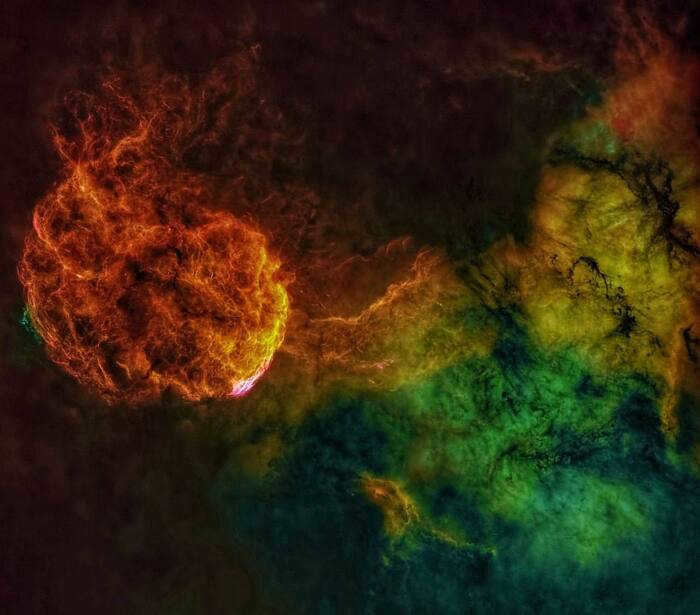
Different Perspectives of the Milky Way

Brand new comet C/2023 P1 (Nishimura)
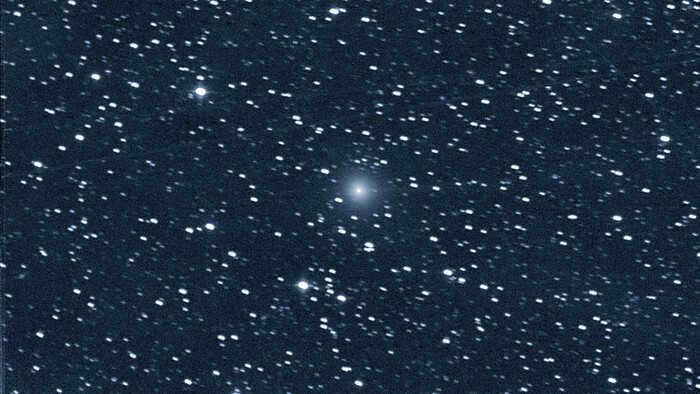
Comets are unexpected visitors. While older comets, which we have known for a long time, can sometimes disappoint us by depleting and melting as they repeatedly approach the Sun, newly discovered comets are often bright and spectacular. However, this is not always the case.
Comet C/2023 P1 was found by Hideo Nishimura, a Japanese astronomer, on the night of August 11-12, 2023, in the constellation Gemini, where it can still be seen. It can be said that the discovery of the comet was a stroke of luck, as finding a faint hazy object (12th magnitude) in the brightening pre-dawn sky requires great luck and demonstrates the highest level of professionalism.
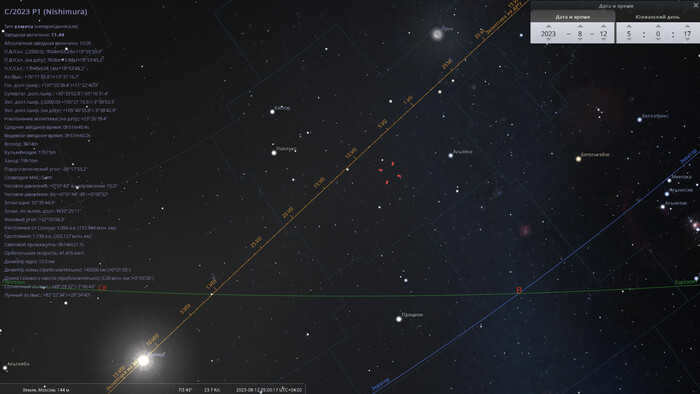
On the morning of August 12, 2023, comet C/2023 P1 was located in the Gemini constellation (at the time of its discovery).
However, the comet’s brightness has been increasing with each passing night. After just one week, it is now visible alongside 10 stars and can be observed using medium-power amateur telescopes. Although it is still best viewed before dawn, the overall visibility conditions for Comet Nishimura have improved since its initial discovery.
By September 18, 2023, the comet will reach its perihelion, the point in its orbit closest to the Sun, at a distance of 33 million kilometers from its luminous surface. This is approximately twice as close as Mercury’s proximity to the Sun. However, unlike Mercury, which is composed of rock, the comet is made up of ice. As a result, the ice will start to melt and vaporize well before reaching perihelion. This process is already underway, and astronomers have observed a small tail, measuring only 8-10 angular minutes in length, comprised of gases and dust emitted from the comet’s heated nucleus.
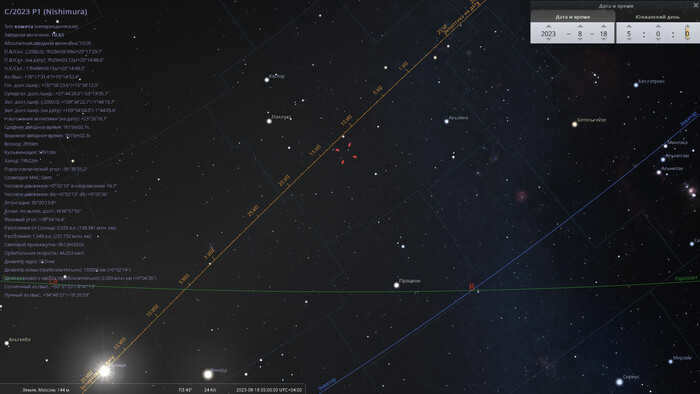
On the morning of August 18, 2023, comet C/2023 P1 can be found in the constellation Gemini.
At the moment, the comet is currently passing through the Earth’s orbit, and it is located on the opposite side of the Sun from our perspective. As a result, the distance between the Earth and the comet is quite significant, measuring one and a half astronomical units. However, this situation is rapidly changing.
By the beginning of September, the Earth will be only 1 astronomical unit away from the comet (and the comet will be only ½ ae away from the Sun). The angle between the Sun and the comet (elongation) will slightly decrease from 35 to 30 degrees. However, this minor setback will be offset by the growing difference in declination between the Sun and the comet. In fact, the tail of the comet will be visible directly above the Sun, providing a great view well before sunrise.
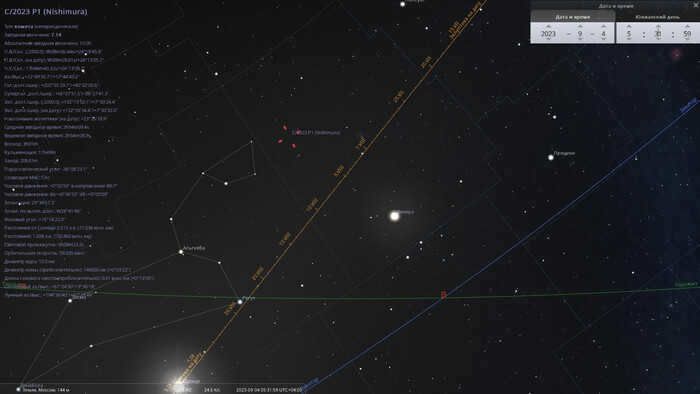
On the morning of September 4, 2023, in the Cancer constellation, you can find comet C/2023 P1.
In the sky, Comet C/2023 P1 Nishimura will be situated in the Cancer constellation, close to the border of Leo constellation (look for the asterism “Lion’s Head” as a useful guide), and nearby, in the same constellation, you will see the bright Venus shining. The comet will reach 7th magnitude on September 4, 2023, and it will be an easily observable object with binoculars.
At dawn on September 9, 2023, comet C/2023 P1 will be just 1 degree to the west of the star Adhafera (Zeta Leo), with a brightness of 6 star magnitude. In regions with optimal conditions, such as mountains, deserts, and steppes, the comet will be visible to the naked eye.
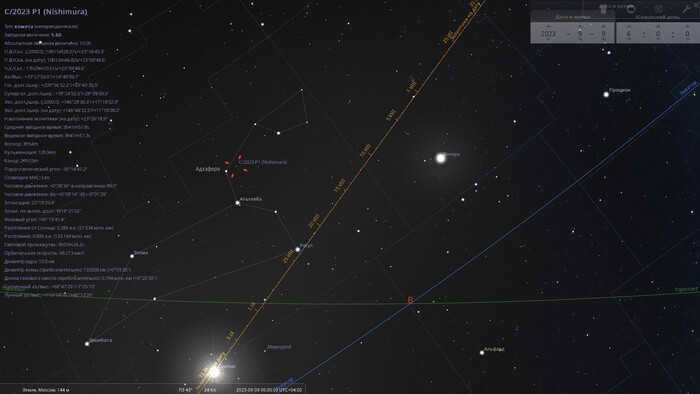
The position of comet C/2023 P1 in the constellation Leo on the morning of September 9, 2023.
Unfortunately, the distance between the Sun and the comet will decrease to 22 degrees, but the comet will rise higher above the ecliptic. Even with this small separation, it will remain visible for at least one and a half (possibly up to two) hours.
In the following days, the comet will continue to increase in brightness, but its distance from the Sun will decrease, making observation more challenging.
By the morning of September 12, the comet will have a brightness of 5 star magnitude and a separation of 17 degrees. It will still be located above the Sun, providing an opportunity to spot it in the morning twilight near the star Zosma (Delta Leo).
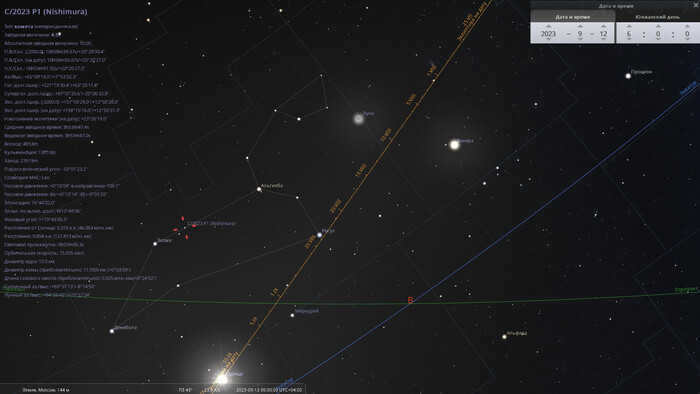
The location of the C/2023 P1 comet in the constellation Leo on the morning of September 12, 2023
On September 15 in the morning, the comet will approach the 2nd magnitude star Denebola (Beta Leo) closely. At the same time, the comet itself will only be slightly dimmer, about 3rd magnitude. However, it will be possible to observe both celestial bodies against the dawn sky, although it will be quite challenging.
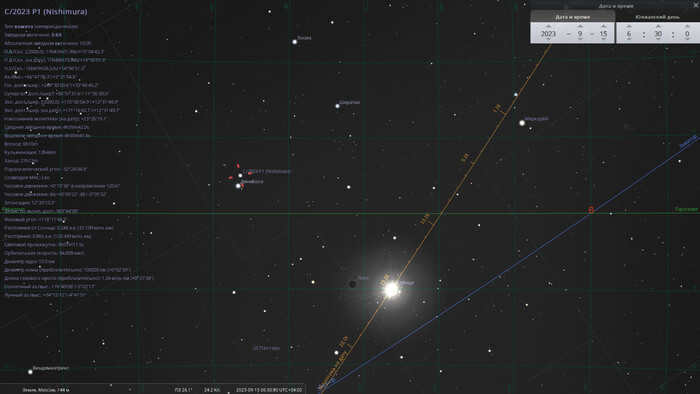
The constellation Leo will be the location of comet C/2023 P1 on the morning of September 15, 2023.
When the comet reaches perihelion, it is expected to have a brightness of around 2nd magnitude. In the evening, shortly after dusk, observers in the northern hemisphere will be able to see the comet in the northern part of the constellation Virgo. However, in the southern hemisphere, it will be either impossible or extremely difficult to observe the comet due to its higher declination compared to the Sun.
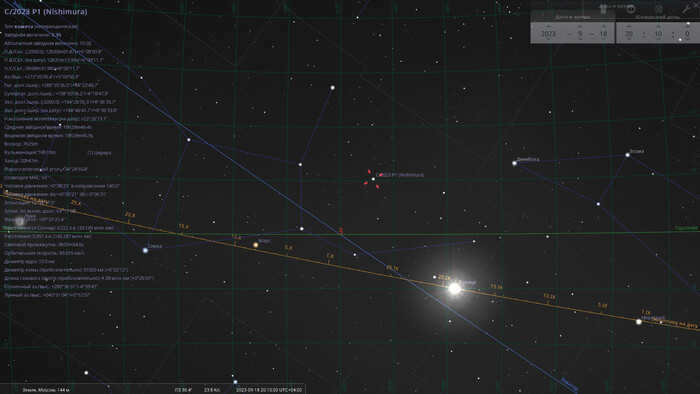
The constellation Virgo will be the location of comet C/2023 P1 on the evening of September 18, 2023 (as it passes perihelion).
As time goes on, the comet will gradually move further into the southern celestial hemisphere and will cross the equator at the same time as the Sun, which will occur on September 21, 2023, just one day before the autumnal equinox. By that time, the comet’s brightness will decrease to 4.5m.
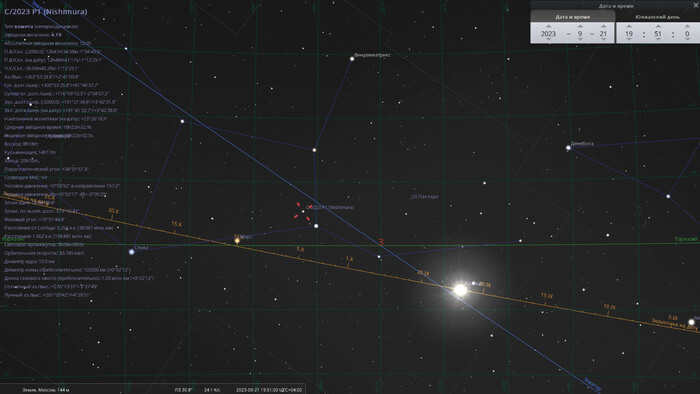
Comet C/2023 P1 can be located in the constellation Virgo on the evening of September 21, 2023.
On October 1, in the evening, you can find Comet C/2023 P1 Nishimura 40 minutes after sunset on the border of the Virgo and Raven constellations. However, to observe it, you would need to be in Australia or the mid-latitudes of South America, or perhaps at the southern tip of Africa. The comet’s brightness will be around 7.5m, so it may not be worth buying tickets just to see it.
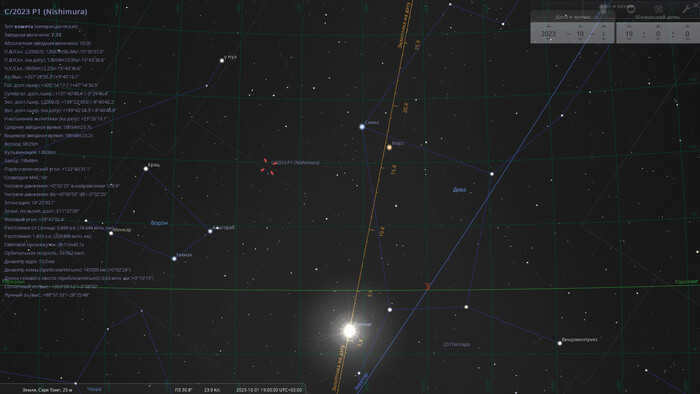
On the evening of October 1, 2023, comet C/2023 P1 will be located at the border of the Virgo and Corvus constellations. This position is specifically for observers in Cape Town, South Africa.
As we move towards mid-October, the comet will continue its journey further south, entering the tail section of the Hydra constellation. Its brightness will decrease to the 10th magnitude, making it less visible even in the southern hemisphere. Eventually, the visibility of the comet will cease for astronomy enthusiasts all around the world.
Not under our observation. Currently, the orbital parameters have only been roughly estimated. This level of precision is sufficient for determining the comet’s location in the celestial sphere for the forthcoming months, but the duration of its orbit remains uncertain. Despite being categorized as a long-period comet, its orbit’s eccentricity is regarded as one, indicating that the comet’s trajectory is nearly parabolic or possibly even exactly so. Consequently, it will eventually come back to the Sun, perhaps in a million years or perhaps not at all.
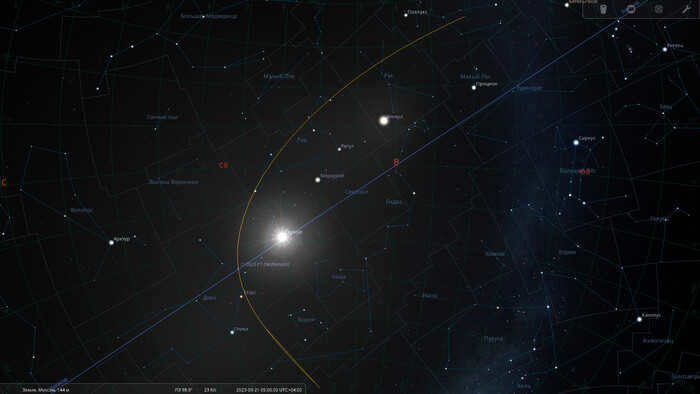
The path that comet C/2023 P1 Nishimura will follow from August 12 to November 1, 2023
All the charts are created with the help of the Stellarium software
The most alluring properties in the solar system
In 1957, the Soviet Union launched the first man-made satellite, a momentous event that marked the beginning of humanity’s exploration of space. Since then, numerous space agencies, private companies, and research institutes have been staking their claim in the vast expanse of the solar system. While there seems to be an abundance of space for all, certain celestial locations have captured the attention of those in the know. One such attraction is the Lagrange points, which have become highly coveted by all interested parties. These points, named after the 18th-century mathematician who discovered their existence, offer unique stability in our ever-changing cosmic neighborhood.
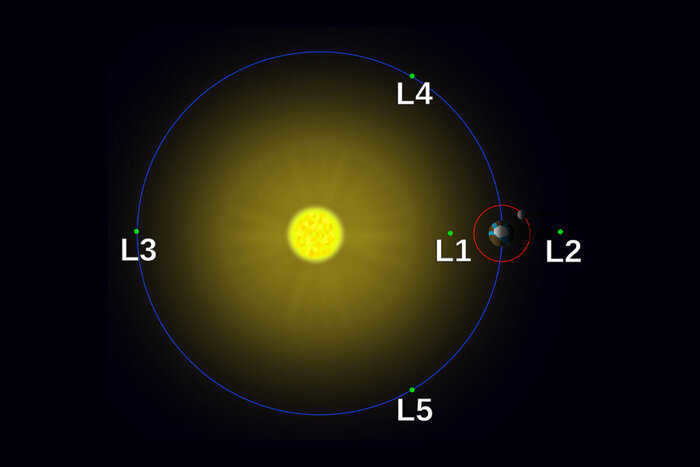
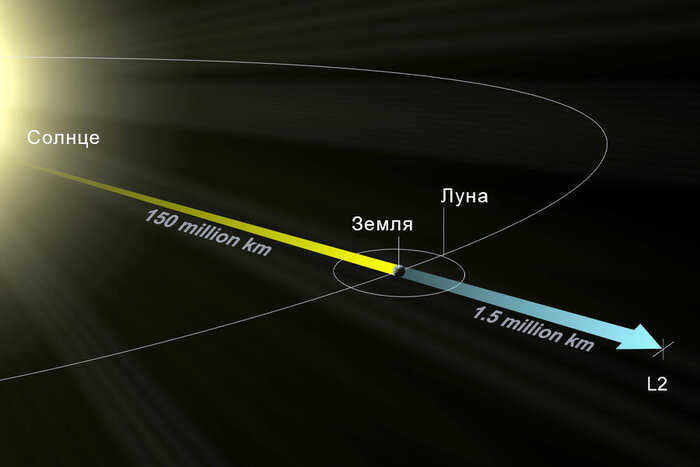
However, our system doesn’t have many conventional “parking lots”. Interactions between massive bodies create five Lagrangian points for each pair of objects. For instance, the Sun has five points where it connects with any planet, and each planet has the same number of connections with its satellites. When adding them all up, we discover that our system boasts over 1000 Lagrangian points. However, only a few of them are practical for human space exploration. Many are difficult to reach, and as we’ll soon find out, not very stable. Currently, only two of these locations are actively utilized, but this may change in the future.
The issue of what can be placed in a specific Lagrange point is rather fascinating. Let’s focus on the ones formed by the gravitational interaction between the Sun and the Earth. L1 is situated approximately 1.5 million kilometers from our planet, between these two celestial bodies. Thanks to the unobstructed view of the star, it serves as a perfect location for observing the Sun.
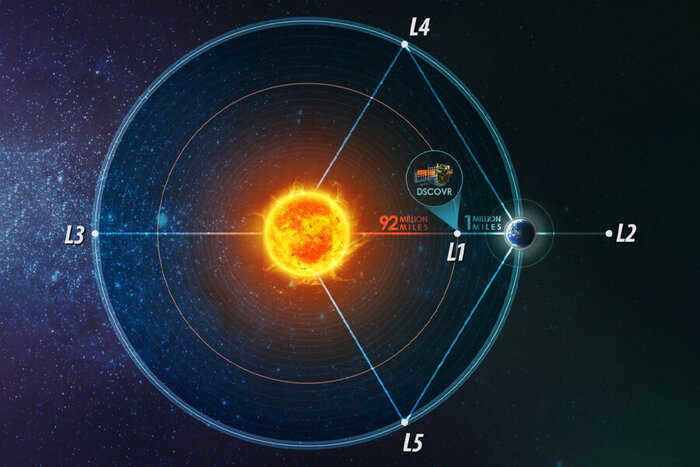
The Deep Space Climate Observatory is a spacecraft for solar and Earth observation situated at Lagrangian point 1
L2 is positioned on the far side of the Earth and at an equivalent distance. This implies that it is securely protected from sunlight and offers distinctive chances for observing in the opposite direction, specifically, space. In 2022, the James Webb telescope, a highly anticipated launch for astronomers over the past twenty years, commenced operations in this location.
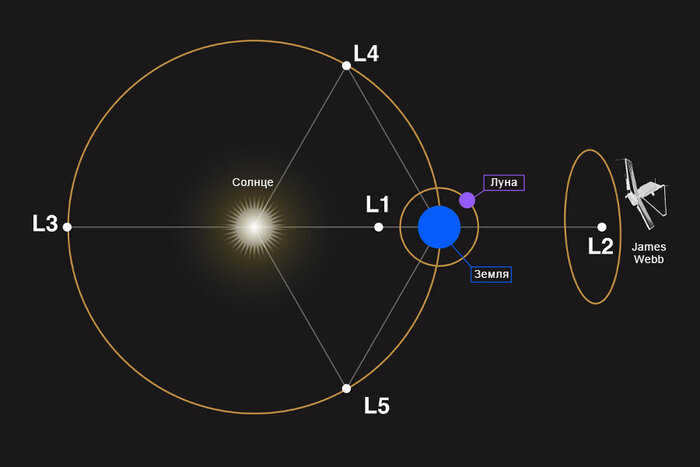
L3 is located in the most enigmatic location, precisely on the opposite side of Earth’s orbit compared to the Sun. It is an extraordinary point in the vast expanse of the Universe that is utterly inaccessible from the planet’s surface, even in theory. This characteristic has made it a popular subject for science fiction authors, although scientists themselves have little practical interest in it.
L4 and L5 exhibit slight differences compared to the preceding Lagrangian points. The distinguishing factor lies in the slight instability present in the initial three points, causing the objects within them to gradually shift position. While it is possible to maintain their position with ease, it does require additional effort. In other celestial body pairings, the stability of L4 and L5 may not be as pronounced, particularly if their masses differ by less than a factor of 25. However, within the Sun-Earth system, where the star possesses significantly greater mass than the planet, these points demonstrate remarkable stability. Furthermore, they appear to attract a variety of objects, with the most notable example being the accumulation of thousands of asteroids in the L4 and L5 positions of the Sun-Jupiter system.
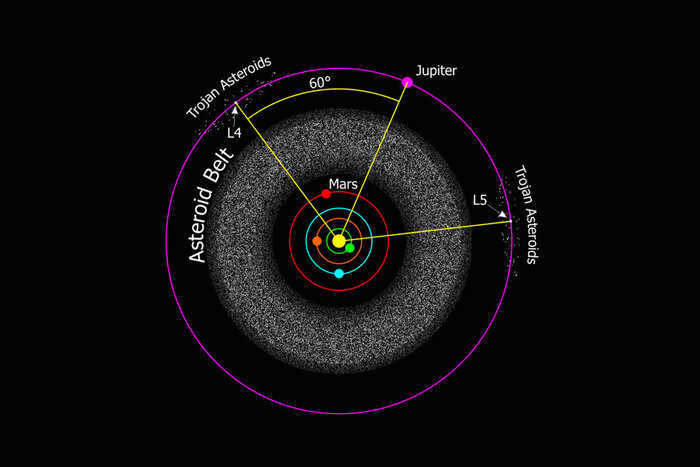
Each Lagrangian point in the solar system has its own unique characteristics. Some of them have the potential to serve as sources of building materials, with drifting asteroids being a prime example. Others could serve as refueling stations for spacecraft traveling through space. It’s also possible that these points could be ideal locations for human colonies to be established. Of course, this is all speculation and something that may only happen in the distant future, a future we may not live to see given the current state of affairs on Earth. But it’s always good to dream, isn’t it?
Thank you for taking the time to read this article! If you enjoyed it, you have the option to show your support by giving it a “plus” or subscribing to this channel. We would also like to inform you that we have our own Telegram channel, where we regularly share fascinating posts about space and astronomy.
We genuinely value each and every one of our readers. If you would like to contribute financially (using the button below), your name or nickname will be included at the end of our next post. It’s our small way of expressing our gratitude for your generosity and support!
What is responsible for the length of refractor telescopes? The issue of chromatic aberration provides the answer to this question.
Refractor’s Chromatic Aberration
Achromatic refractors are known to have a drawback called chromatic aberration. This issue arises from the refraction of light as it passes through the lens system of a refractor. The dispersion of light causes rays of different wavelengths to be refracted at different angles, resulting in a disparity in refraction. As a result, an iridescent border becomes apparent around the observed object and its finer details.

The primary element of a telescope is an essential factor that determines the quality of the image produced. When chromatism is significant, it can cause the image to become blurred. To address this issue, refractors incorporate a solution by utilizing two lenses instead of one. The second lens is designed to compensate for the chromatic aberration introduced by the first lens. By employing this approach, the refractor is able to greatly reduce the effects of chromatic aberration and enhance image clarity.
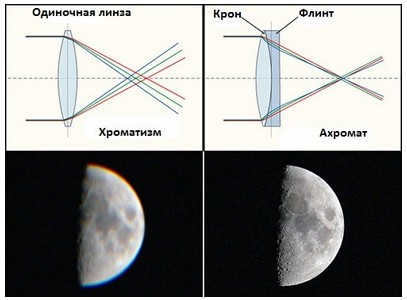
Reasons behind the increase in the focal length of a refractor with the increase in aperture
A refractor with a sufficiently large focal length is able to overcome residual chromatic aberration. The minimum focal length required for a refractor with a given aperture can be roughly estimated using the formula D^2/10. For example, with an aperture of 50 mm, the minimum focal length should be at least 50^2/10 = 250 mm.
The requirement for minimum focal length increases rapidly due to the squaring of the aperture, which explains the longer length of refractors. This also explains the limitation on aperture – a refractor-achromat with an aperture of 200 mm would require a minimum length of 4 meters, making it impractical for amateur use without a mount capable of supporting such a telescope.
Here is a table displaying the minimum focal lengths for different apertures:
| 50 mm | 250 mm |
| 60 mm | 360 mm |
| 70 mm | 490 mm |
| 76 mm | 580 mm |
| 80 mm | 640 mm |
| 90 mm | 810 mm |
| 100 mm | 1000 mm |
| 127 mm | 1600 mm |
| 152 mm | 2300 mm |
If we consider the human eye as an optical instrument, it has limited resolution, low magnification, and low luminosity. That’s why we need special devices to observe wildlife, sporting events, celestial bodies, and distant objects. The most powerful of these devices is a telescope – an optical system that captures a small area of space and magnifies objects within that area. The telescope collects parallel rays of light and focuses them onto a point on the optical axis. The eyepiece then converts these divergent rays into a parallel stream, allowing us to see distant objects in detail. The size of the visible area depends on the telescope’s magnification and the eyepiece’s field of view.
Lens telescopes (refractors)
There are two primary categories of telescopes, which vary in their method of focusing the light rays. The more advanced telescopes utilize one or more lenses as the objective lens, thus earning the name lenticular or refractors.
Refractors possess several advantages over telescopes of alternative systems: an enclosed optical tube (preventing dust and moisture from entering), optically fixed elements (no adjustments necessary), no central obstruction (reducing light interference and diffraction pattern distortion). When observing planets, refractors offer high contrast and exceptional resolution. However, there are drawbacks to this type of telescope. The primary concern is chromatic aberration, where light rays of different wavelengths do not converge at the same focal point. This leads to the appearance of colored halos around bright objects. To address this issue, special correctors made of particular types of glass must be used. Additionally, refractor lenses require at least two lenses, each with precise curvature radii, thorough polishing, and an anti-reflective coating. These factors increase the manufacturing cost and final price of refractors.
Reflecting telescopes (mirror telescopes)
Reflectors or mirror telescopes, the second major category of telescopes, utilize a mirror to focus light. This design was pioneered by Isaac Newton, who is often credited with the development of Newton telescopes. The concave mirror in these telescopes has a spherical or parabolic shape. Unlike refracting telescopes, the light is not transmitted through the mirror but instead is reflected off it. This optical system produces images without color halos, known as chromatic aberration. In smaller reflectors and long-focus telescopes with an aperture less than f/9, spherical mirrors are commonly used. However, for larger telescopes and models with a relative aperture greater than f/8, spherical mirrors are not suitable. This is because a spherical mirror causes the reflected light beam to not converge at a single point, resulting in a slightly blurred focal spot. This phenomenon, known as spherical aberration, reduces image contrast. To counteract this effect, parabolic mirrors are employed.
The light that enters the telescope first hits the main mirror. In order to view the image, the light needs to be directed to the eyepiece. This is where the secondary mirror comes into play. It is a flat reflecting surface with an elliptical shape, positioned at a 45-degree angle to the main mirror’s axis. The secondary mirror directs the light towards the eyepiece assembly. Although the secondary mirror cannot be seen through the eyepiece, it does obstruct the light flux, resulting in a slight loss of contrast in the images due to diffraction. Reflective eyepieces are located at the front of the telescope tube, allowing for a closer mounting to the ground without compromising comfort and stability during observation. Reflectors have an advantage in terms of production cost, as they only require polishing and enlightenment for two optical surfaces. However, reflectors have some drawbacks, such as a longer optical tube length, which makes them more susceptible to vibrations and wind. Additionally, regular adjustments of the optical elements are necessary.

The optical design of the Schmidt-Cassegrain telescope consists of a thin aspherical correction plate that corrects for spherical aberration. Light enters the main concave mirror through the correction plate and is then reflected onto a secondary mirror, which directs the light into a central aperture in the main mirror. Behind the main mirror, there is either an eyepiece or a diagonal mirror. To focus the telescope, the main mirror or the eyepiece is adjusted. The main benefits of telescopes utilizing this system are their portability and long focal length. However, a drawback of this system is the relatively large secondary mirror, which obstructs some of the incoming light and leads to a slight reduction in contrast.
The design of the Maksutov-Kassegren telescopes is similar to that of the Schmidt-Cassegrain telescopes. These telescopes also utilize a corrector, which is a thick meniscus lens with a convex curve, to correct for spherical aberration. Light enters the primary mirror through the meniscus and is then reflected to the secondary mirror, which is often a mirror-coated area on the convex side of the meniscus. Similar to the Schmidt-Cassegrain system, the light passes through an aperture in the primary mirror and reaches the eyepiece. The manufacturing process of the Maksutov-Cassegrain telescopes is easier compared to the Schmidt-Cassegrain system, but the inclusion of a thick meniscus in the optical system adds to their overall weight.
An enjoyable pastime
Manufacturers of telescopes often try to attract buyers by promoting the high magnification capabilities of certain models. For instance, a telescope with a 60 mm aperture may advertise a magnification of 600 or more. However, what these advertisements often fail to mention is that observing celestial bodies at such high magnifications is usually not feasible due to atmospheric turbulence. When looking through a telescope, the observer is viewing objects through a layer of air that extends to the edge of the atmosphere, and this air is rarely still. Turbulence in the atmosphere can cause distortions, similar to trying to see through rippling waves of heated air. In order to determine the maximum useful magnification under good conditions, one can multiply the lens diameter in millimeters by two. Under optimal conditions, magnifications equal to or greater than three times the lens diameter in millimeters can be used, but such conditions requiring both clarity (still air) and transparency (minimal water vapor or particulate matter in the air) are exceedingly rare in amateur astronomy. In highly turbulent atmospheres, the large aperture of a telescope can actually hinder image quality because it captures more areas of turbulence. In these cases, it is recommended to use an aperture that reduces the telescope’s light diameter and resolving power, while also minimizing the effects of atmospheric turbulence.

Rectifying deviations
The position of the focal point for rays passing through a lens made of regular glass, like kronglas, can vary and depends on the wavelength of light. Using a glass prism, we can observe the separation of white light into different wavelengths. This physical property of light causes the refracted rays to not converge at a single focal point. This phenomenon is known as chromatic aberration and it results in blurred images and a colored halo around observed objects. Reflecting telescopes that do not use refractive lenses are not affected by this phenomenon, but they may experience spherical aberration, which is an image defect caused by inaccuracies in the processing of mirror or lens surfaces. Spherical aberration also causes light rays to focus incorrectly.
The battle against aberrations has a long history. Initially, the length of the telescope’s optical tube was increased to correct aberrations. By adjusting the relative aperture, which is the ratio of the aperture (lens diameter) to the focal length, the effects of aberrations could be reduced. However, this method resulted in very long telescopes and could only be used for small lens diameters.
Another method of correcting aberrations was to use an additional lens to compensate for the objective lens’ aberrations. For instance, by combining a low dispersion glass BK7 magnifying lens with a Flintglass F2 reducing lens, all light rays could be accurately focused. These lenses could be mounted in special frames with a specific distance between them or they could be glued together into a single plate. A refractor telescope with this lens system is known as an achromat. An achromatic lens effectively corrects chromatic aberration and is widely used by major telescope manufacturers. The Sky-Watcher lineup includes the 1201EQ5 and 15012EQ6 telescopes, both equipped with such lenses.
In order to completely eliminate color halos in images, lens manufacturers use other combinations of optical elements and special types of glass. Telescopes created using these technologies are known as semi-apochromats, which provide maximum reduction of chromatic aberration, and apochromats, which are completely free of chromatic aberration. However, these models are significantly more expensive compared to conventional achromats.
What is the objective of lumen
The transmission of light and the quality of images can be negatively affected by the reflection of light rays on both the outer and inner surfaces of a lens. To mitigate this issue, manufacturers employ special techniques to minimize light loss. One such method is the use of lens coatings, such as magnesium fluoride, which are specifically designed to reduce reflection. When both surfaces of a lens are coated, it is considered to be fully coated. If a lens has multiple layers of coating, it is referred to as having a multi-layer coating.
Reflector telescopes also require coatings to minimize light loss from reflection on the mirror surface. Modern reflector telescopes use a thin layer of aluminum for the mirror, which is protected by a special layer of silicon monoxide or silicon dioxide to guard against external factors. The process of applying a silicon dioxide coating is complex and adds to the cost of the telescope, but it provides maximum protection for the mirror.
All Sky-Watcher reflector telescopes feature mirrors with a multi-layer silica coating.
Solution
Resolution refers to the level of detail in the image produced by a telescope. The ability of a telescope to resolve fine details depends on two factors: the size of the light aperture and the quality of the optical surfaces. Increasing the aperture size will proportionally increase the resolving power. In simple terms, a larger aperture allows more light to enter the telescope lens, resulting in a more detailed image. Resolution is typically measured in angular seconds (with 60 angular seconds in an angular minute and 60 angular minutes in a degree).
The quality of the optical surfaces is also crucial in achieving good resolution. Irregular curvature, poor fixation, or surface defects can cause different types of aberrations.
When observing the Moon or planets through a telescope, we can see relatively large images of these objects. With high magnifications and favorable weather conditions, the level of detail in the images increases. However, when observing stars, even at high magnifications, we only see point sources of light surrounded by concentric rings caused by light diffraction. The size of these rings, known as Airy disks, decreases as the telescope aperture increases.
One way to estimate the resolving power of a telescope is by attempting to visually separate the Airy disks of double star systems. The resolution criterion for double stars, known as the Dawes limit, was developed in the 19th century by amateur astronomer Dawes. It determines the minimum distinguishable angular distance between double stars of equal brightness and is calculated using the formula 116/D, where D is the telescope diameter in millimeters. It’s important to note that this formula provides an approximate result, and the exact resolving power of a telescope can only be determined through practical observation. Additionally, modern high-quality telescopes often exceed the theoretical Dawes limit in terms of resolving power.
Components of a telescope
- A telescope can consist of a lenticular system, which uses lenses to refract light;
- Alternatively, it can use a mirror system to reflect light;
- Another option is a catadioptric system, which combines mirrors and lenses.
The GoTo control system is an electronic system designed to accurately point at celestial objects. It requires pre-referencing to the current date and time, precise alignment with the world pole, and alignment to 1-3 stars. The control panel already contains a database of celestial objects, eliminating the need for manual pointing and orientation.
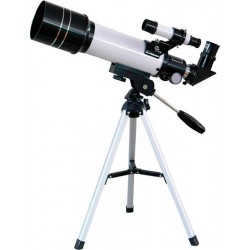
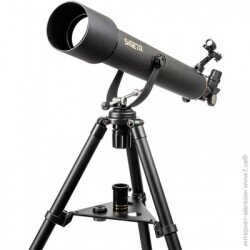
Now, let’s examine this in greater depth.
Refractor telescope
Refractor telescopes employ a system of lenses. They can be categorized as achromats, ED refractors, and apochromats. The primary issue with achromats is the presence of chromatic aberration, which results in the appearance of colored halos around observed objects and diminishes image sharpness and contrast. ED refractors and apochromats represent a more advanced solution. ED refractors incorporate special glass that enhances image quality. Their higher cost is attributed to the use of ED glass.
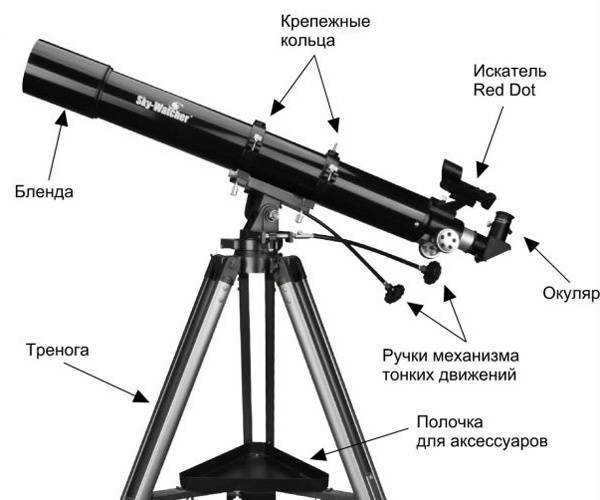
Apochromats are renowned for providing unparalleled image quality compared to other optical systems. These telescopes are equipped with 3-5 lenses made from specialized glasses, such as fluorite, which happens to be the most expensive material in the field of optics. While these telescopes may be costly, they are capable of meeting the most stringent requirements and demands.
Refractors are particularly well-suited for observing celestial bodies such as the Moon, planets, and binary stars. They are considered one of the most reliable types of telescopes as they do not require frequent adjustments or lengthy thermal stabilization prior to observations. Furthermore, refractors can be used for astrography, allowing users to capture stunning images of astronomical objects.
Telescope with a reflective mirror
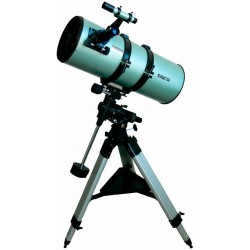
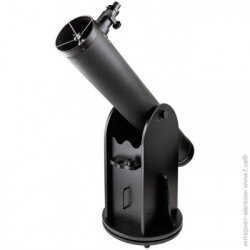
In reflector-type telescopes, the concave mirror serves as the lens, gathering light at the focal point similar to a refractor lens. However, unlike refractors, which refract light as it passes through the lens, reflectors reflect and concentrate light using the main mirror. Among reflectors, the Newton system telescopes are particularly favored, as they are cost-effective to manufacture, making them widely accessible. Newton system telescopes with Dobsonian mounts are especially popular among novice astronomers.
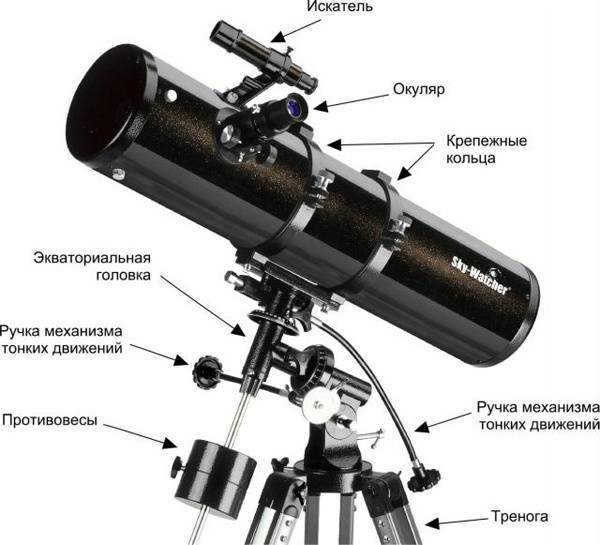
The Cassegrain system is a type of reflector, but its variations, the Doll-Carkham and Ritchie-Cretien systems, are more widely preferred. The Ritchie-Cretien system is highly favored by both amateur and professional astronomers. Many renowned telescopes worldwide, such as the Hubble Orbiting Telescope, utilize this particular configuration. However, for casual stargazing purposes, the complexity of this optical arrangement may not be necessary.
Reflectors offer several advantages, such as the complete absence of image aberrations. To put it simply, they provide exceptional image contrast. Moreover, their high luminosity makes them an ideal tool for observing objects in foggy conditions. However, there are also a few drawbacks to consider. One downside is the instability of alignment, which requires periodic adjustment of the telescope’s elements. Additionally, the “Newton tube” takes a long time to reach thermal equilibrium, resulting in image distortion and movement. In cheaper telescopes, the mirrors are typically of inferior quality, and the tube size is often large, leading to increased sensitivity to vibrations.
Catadioptric Telescope: An Innovative Combination of Lenticular and Mirror Telescopes
A catadioptric telescope is a revolutionary system that combines the best features of lenticular and mirror telescopes. One popular example of this system is the Schmidt-Cassegrain telescope, highly favored by amateur astronomers. These telescopes boast compact tube sizes, lightweight construction, and fewer mounting requirements compared to similar aperture Newtonian telescopes. Additionally, they deliver exceptional image quality, making them a top choice for stargazing enthusiasts.
Another intriguing mirror-lens system is the creation of Russian optician Dmitry Maksutov. Maksutov’s telescopes, known for their absence of aspherical surfaces, are available on the market, albeit at a higher cost.
The main advantages of catadioptric telescopes lie in their compactness and ability to produce stunning images. However, it’s worth noting that these telescopes tend to be more expensive and require specific observing conditions for optimal performance.
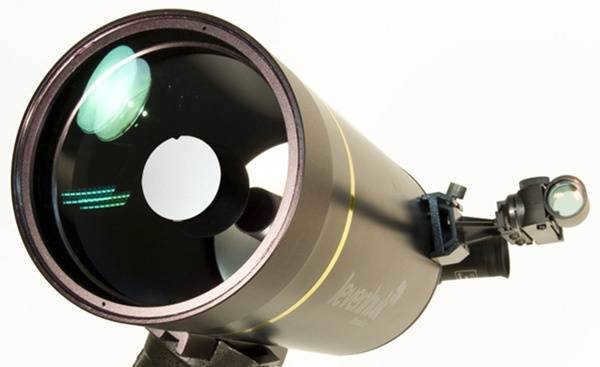
Various Types of Telescope Mounts
The mount is a crucial component of a telescope, just as important as the optical system. Even with state-of-the-art optics, a telescope will fail to produce clear images if it is mounted on an unstable mount. The slightest touch or a gentle breeze can cause vibrations and result in blurry images.
There are several different types of mounts available:
- Azimuthal mounts have two axes of rotation, vertical and horizontal, making them ideal for terrestrial viewing and sky observation. They are user-friendly and require no adjustments. A popular variation is the Dobsonian mount.
- Equatorial mounts are considered to be the most versatile and commonly used mounts in the field of astronomy. These mounts are often found in professional telescopes and are equipped with advanced features such as fine motion mechanisms or even electric drives. This allows astronomers to operate the telescope remotely, using a remote control.
- On the other hand, GoTo mounts offer a more convenient and time-saving option for observing celestial objects. With a computerized mount, astronomers can easily locate and track objects without wasting valuable observing time on manual searching.
When it comes to optical systems, mounts, aberrations, lenses, and mirrors, there are plenty of options to choose from. However, the question remains: what should you choose?
One crucial factor to consider is where you’ll be observing the night sky. In urban areas, there’s often a significant amount of “light pollution” caused by streetlights and residential lighting. It’s important to keep in mind that larger diameter telescopes collect more light, which includes unwanted light pollution.
If you plan to observe the sky from your apartment balcony, the most ideal option would be a compact refractor or catadioptric telescope with a diameter of up to 120mm. These types of telescopes are lightweight, user-friendly, and not greatly affected by light pollution.
On the other hand, if you reside outside of the city, you have the advantage of a clearer sky, allowing for the observation of smaller celestial objects. Telescopes with a diameter of up to 200mm are recommended. In rural areas with dark skies, the only limitations are your budget and physical strength, as larger telescopes can be quite heavy.

